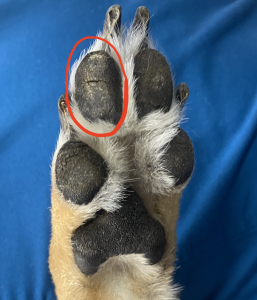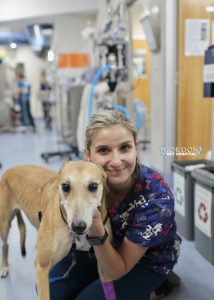Corns
By Kay Hisano | Dated September 6, 2023
When you hear the word corn/corns what is the first thing that you think of? For those of you imagining a beautiful yellow vegetable that tastes delicious alongside a nice steak with some butter, I am sorry to disappoint you but that is not quite the one we will be discussing today.

Maisy’s corn on digit 4.
Maisy, the lovely 10-year-old Greyhound came to see Dr. Tahlia this month. Maisy had been limping on one of her front legs and her owner was highly suspicious that a corn had developed on Maisy’s right forelimb. On examination, Dr. Tahlia confirmed the presence of a corn on Maisy’s outside toe.
Corns are hard pieces of tissue that form in paw pads of dogs that cause a lot of pain and discomfort when pressure is placed on them. They can be incredibly painful – imagine having a little pebble in your shoe that you stand on every time you take a step! Corns most commonly form in greyhounds but can also sometimes affect other breeds of dogs. They are commonly caused by repetitive mechanical trauma to the paw pad and some dogs are genetically predisposed to forming multiple corns over their lifetime. They can vary in appearance but are typically pale circles on the surface of the pad as can be seen in the image above.
Although historically corn removal surgeries were predominantly the treatment of choice, at Gordon we have started recommending a tenotomy to treat foot pad corns for patients like Maisy. All tenotomy involves is the removal of a small section of the superficial digital flexor tendon that attaches to the affected toe. This unloads pressure off the affected toe which means less weight is placed on that toe with every step. The change in distribution of weight between the toes gives instant pain relief and means that the corn will eventually grow out and disappear.
Removing a small section of the tendon sounds like a scary surgery, but it is actually much less painful than traditional corn removal surgery. A tenotomy only requires a very small incision alongside the tendon at the back of the leg. Unlike traditional surgery where the corn is cut out of the paw pad, with a tenotomy our patients do not have to walk on the surgery site while it is healing. It instantly relieves pressure from the toe affected by the corn and many patients even walk better on the way home than when they arrived in the morning. Although there is a chance that the tendon attaches itself back together, this is only a very small percentage and a repeat tenotomy can be done.
A few weeks after her tenotomy, Maisy is doing well at home and she is now able to enjoy pain-free zoomies again!
If you’ve noticed that your lovely rescue greyhound is limping or seems painful on their paw pad, bring them in to see our friendly team for a corn check.

Maisy post-surgery with nurse Maggie.
